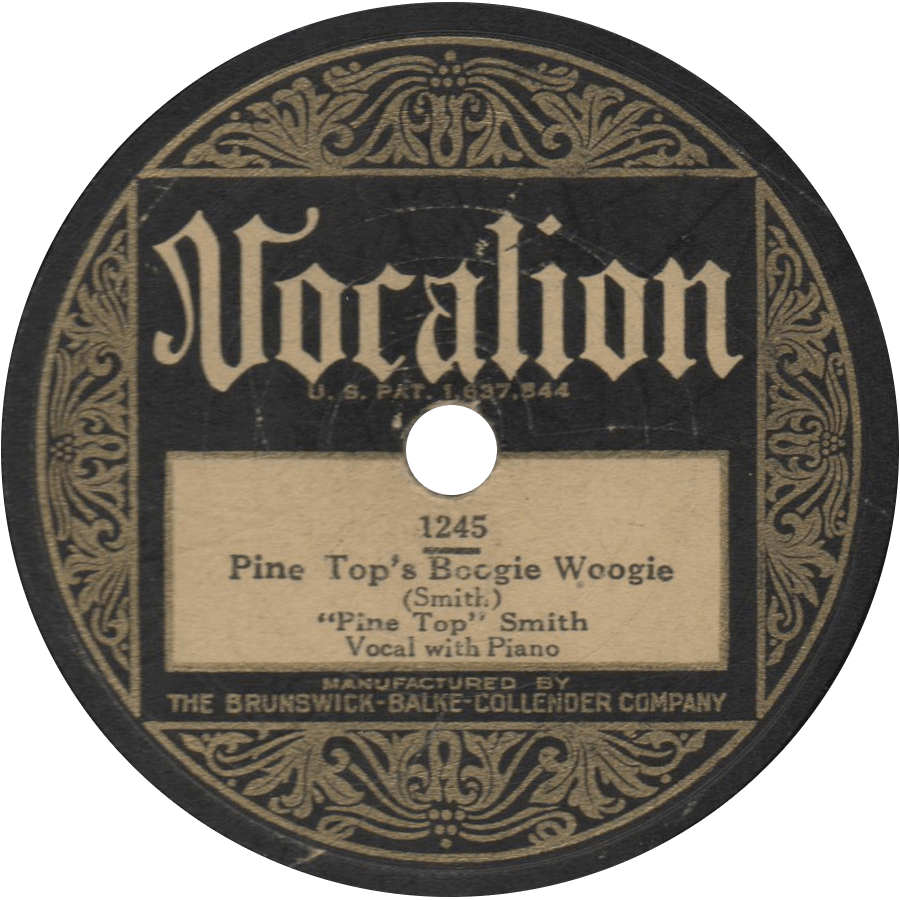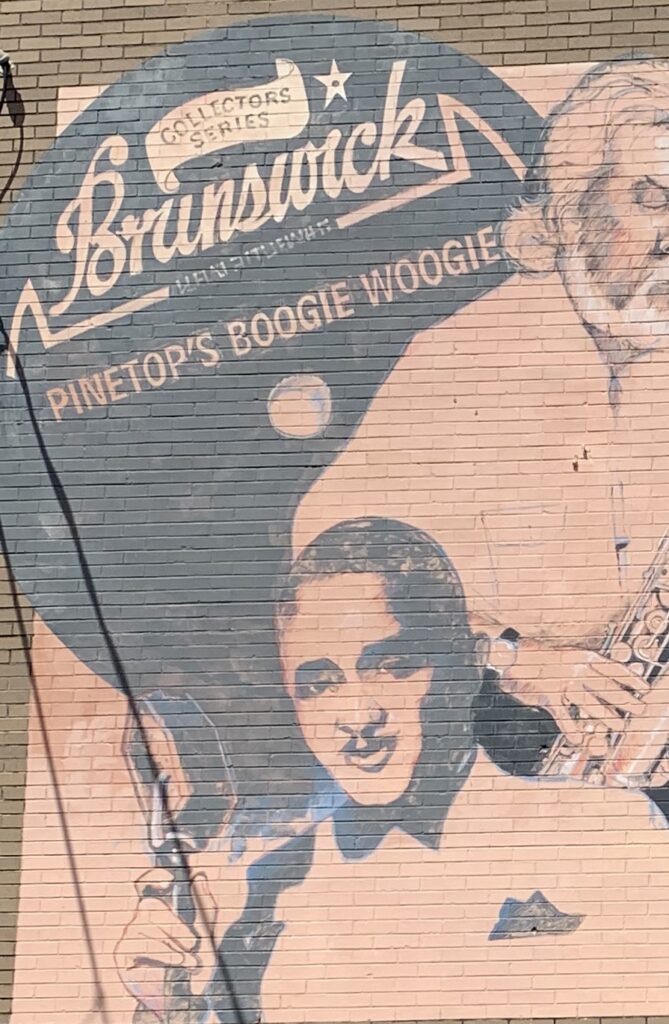2014 Honoree
(1904 – 1929)

Clarence “Pine Top” Smith was born January or June of 1904, in Orion, Alabama in the heart of southeast Alabama. He went on to become an internationally acclaimed blues pianist and cited as one of the originators of “boogie-woogie.” In 1928 he released “Pine Top’s Boogie Woogie” which was the first time the phrase “boogie woogie” appeared in a recorded song. His music and performance style was shaped by Southern barrel-house blues that evolved in the Southern turpentine camps, brothels, juke joints and traveling vaudeville blues shows of his day. Pine Top’s performance style was rooted in the early blues and vaudeville tradition and as a result, he was not only an outstanding musician but also an all-round entertainer. He was particularly known for his comedic, witty and lyrical banter that he famously “rapped” over the driving rhythms of his piano playing. Pine Top Smith is also considered one of the founding fathers of rap. At the time of its release, “Pine Top’s Boogie Woogie,” was a major hit and is cited as having a pivotal impact not only on the story of the blues but the broader evolution of American music as a whole right up to the eventual emergence of rock and roll and rap.
He was born was in the tiny community of Orion, north of Troy, in Pike County, to Sam and Molly Smith – one of five children. At this time, most African Americans lived in conditions of extreme rural poverty, under the repressive conditions of Jim Crow Laws, and were mostly destined to work as indentured sharecroppers eking a subsistence survival level of existence. The family moved to Troy soon after his birth and according to his wife, it was his childhood love of climbing trees earned him the nickname “Pine Top.” Certainly, this region is known for its plentiful pine tree forests. Little is known about these early years but it is likely that Smith had his first exposure to piano in a local church and had his first exposure to blues music on the streets and in local juke houses. By his early teens, he was already playing house parties in the Troy area. He was serious about music and soon moved to Birmingham, a regular destination for traveling blues shows where there was a vibrant music scene. He was based out of Birmingham for a couple of years and played in local venues, including the East End Park Club. In Birmingham he connected with fellow blues musicians, including barrel-house piano player and Aliceville, AL, native Robert McCoy. With Birmingham as his base, Clarence “Pine Top” Smith soon began to seriously travel and perform and in 1919, then a young teenager, is credited as a member of “Mattie Dorsey’s Big Four” at an appearance in Memphis, Tennessee.
This was the dawn of the “Roaring Twenties” and the “Jazz Age,” with its craze for big bands and wild dancing. Solo piano players had to compete to win the approval of the dance-crazy public in noisy crowd-filled venues. Some found they could delight dancers with a fast-pass blues-style with a rolling left hand bass line and repeated patterns of eighth notes, rather than quarter notes. With its rag-time, sacred, jazz and blues influences, the musical gumbo boogie-woogie style was born. The style evolved in barrel-houses, house parties, turpentine camps, brothels, theaters and juke joints in the South during the 1900s and traveled with the musicians who migrated to the northern cities. It should also be noted that Perry Bradford (Alabama native/music entrepreneur, blues piano player and colleague of W.C. Handy) stated in his autobiography that the first time he heard the “boogie-woogie” was in Chicago in 1906 played by a mysterious piano player also from Alabama called “Lost John.”
It should be noted that guitar players were also experimenting with this style. Mississippi delta bluesman Robert Johnson was noted to be an innovator of the “rolling bass line” that he plucked out on the lower strings of his guitar – and that Robert made his big musical breakthrough while studying with Ike Zinnerman, his elder guitarist mentor. Ike had learned guitar growing up in the Wiregrass region, born in Grady, less than 30 miles away from Troy – from older wiregrass blues musicians. It is not a great leap to surmise that it was Wiregrass bluesman Ike who brought this style with him when he moved to Mississippi to work and transmitted it to Johnson, who went on to record and get credit for this stylistic innovation. Then again, as it is rarely pointed out. Johnson appears late in the story of the blues – and is given far more credit than he is due in terms of blues origins. He died age 27 in 1938 – and recorded only a few sides almost a decade after Pinetop had died.
Solo blues musicians had a lot of pressure to carry the show alone and had to be all round entertainers. Pine Top found he would add excitement to his performance by “rapping” to the audience, encouraging the dancers and giving instructions, like calling “the girl with the red dress on” to “shake that thing” and “mess around.” Smith was one of the top virtuosos of the style just as the genre was gaining wider popularity
By age sixteen, the ambitious young Smith joined the thousands of African Americans who left the South and headed north, as part of the Great Migration, to arrive in Pittsburgh, which had its own renowned thriving jazz and blues scene. There was also a burgeoning black urban middle-class that had money to spend and enjoyed the opportunities for top notch entertainment. He soon found work in the bustling nightlife of the Hill district, nicknamed “Sugar Top.” This was heart of the entertainment district with plenty of opportunities for regular late night gigs in the lively night clubs, dance ballrooms, and theaters. Smith was not alone and many Southern jazz and blues musicians migrated to take advantage of the opportunities of to be found in this thriving music scene. He found a regular job playing piano in a club on Wylie Avenue and exposure to abundant talent that played in the numerous surrounding “Sugar Top” venues.
There are no known photographs of Pine Top Smith but reports by contemporaries describe him as an enigmatic character, handsome, dapper and well dressed. He was also reported to be fond of alcohol, slept of the effects during the day and came to life in the evening – a reputed womanizer and not only played in the red-light district but also frequented the use of services provided there.
He gained great experience on the southern traveling road show circuit and performed with many acts, including The Raymond Brothers, The Whitman Sisters, and Matt Dorsey’s Pickaninnies. The legendary Wiregrass native Ma Rainey had also had relocated to Pittsburg and for a time chose to base her traveling show in the thriving musical scene there. She hired Smith to join her entourage of performers and he toured on the vaudeville T.O.B.A (Theater Owners Booking Association – also nick named by the musicians Tough On Black Asses – for it’s grueling schedule and living conditions on the road) theater and tent show circuit as a piano player, singer, tap dancer and comedian. His reputation grew and he toured with prestigious acts besides Ma Rainey, like Birmingham, AL, native Coot Grant and Wilson, and Butterbeans and Susie. With the TOBA circuit he played all over the south including: Barleys 81 Theater and the Lyric Theater, New Orleans; Koppins Theater, Detroit and the cities of Atlanta and Memphis. Though based out of Pittsburg, Smith traveled extensively to perform and is known to have lived for short periods in St. Louis, Missouri and Omaha, Nebraska, where he spent periods of time playing clubs, rent parties and whore houses.
He returned to Pittsburgh between tours, performing in local clubs and cabarets. It was at the Rathskeller on Wiley Avenue in 1924 where he met and fell in love with Sarah Horton. He married her on October 11, 1924, when he was twenty. Sarah was originally from Charlotte, NC. “Pine top and I just seemed to fall in love right away- we always got along swell.”
In Pittsburg, sometime after his marriage, Smith connected with fellow Anniston, AL, native, bluesman Cow Cow Davenport. Davenport was already a veteran piano player who had toured extensively and was at the time working as a talent scout for Brunswick/Vocalion Records based in New York and Chicago.
The “race” recording boom was flourishing and blues 78 record sales were booming as African American music performed by African American musicians was being commercially recorded for the first time. Davenport went to hear Pine Top at a local honky tonk called the Sachem Alley, “a chilly parlor and beer garden.” Cow Cow was very impressed and is quoted as saying to Pine Top, “Boy, look here, you have got a mean boogie woogie.” There is great debate as to who first used the word “boogie woogie.” Cow Cow claims he brought the expression with him from Alabama – his grandmother told him as a kid that the boogie man would get him for playing the devils music. Cow Cow Davenport had been kicked out of Seminary in Selma for playing “rags and blues.”

On Davenport’s recommendation, and in hopes of recording, in the summer of 1928 Smith moved his wife and son, Clarence Jr., to Chicago. There he shared a Prairie Avenue rooming-house with piano players Albert Ammons and Meade ‘Lux’ Lewis and soon gained notoriety performing Chicago rent parties, speakeasies and also enjoyed a regular gig at the Forestville Tavern on 47th and Forestville. His wife recalls they were frequently visited by musicians, including Jelly Roll Morton, Tampa Red and Earl Hines. After a short period he auditioned at the Brunswick-Balke-Collender studio. In early December, Smith went into the studio to record at Brunswick/Vocalion but left disappointed as these first recording sessions were aborted. On December 19th, he returned and recorded “Pine Top’s Boogie Woogie” and struck gold. This was the first pure boogie woogie barrel-house music to be recorded and two months later it was a major hit. On January 14th and 15th, 1929, he returned and recorded six more songs, including “Pine Top Blues,” “I’m Sober now” and “Jump Steady Blues.” On March 13, 1929, Pine Top recorded a ninth song which was never released and he was scheduled to return to the studio to record again the next day.
Tragically, Smith had little chance to enjoy his success or fulfill a promising career. On the night of March 14th, the twenty-five year old maestro left home to rehearse with Ernest Wallace. On his way back home, Pinetop was passing the Masonic Adams Lodge Hall on Orleans Street. Attracted by the music, he entered the hall where 300 people were attending a dance and seeing some friends, Pinetop soon joined them on the dance floor. As they danced, a fight broke out between two guests. David Bell pulled a gun to break up the fight and Pine Top was accidentally shot in the scuffle. Pine Top was taken to the hospital but never regained consciousness. He died at 1:18am, leaving behind his wife, two children and eleven recorded tracks. (interesting accounts including a female sax player who gives a witness account). Also, Pine Top was survived by his mother who lived in Columbus GA until her death. David Bell was later acquitted and the verdict given was accidental death.
Pine Top Smith’s, “Pine Top Blues” is considered a ground-breaking and seminal recording. Among the driving forces behind the advent of boogie-woogie he is cited as one of the most influential musicians of the 1920s. He popularized the style and helped to give it its name. His 1929 hit has been covered by many musicians over the years and is considered a classic in the boogie-woogie repertoire. Boogie-woogie went on to become a major craze in the thirties and forties. The song was a major hit for Cleo Brown (1935) and also for Thomas Dorsey and his Orchestra (1938), eventually selling more than five million copies. Bing Crosby and Lionel Hampton also recorded versions of the song (1942). Joe Willie Perkins recorded “Pine Top’s Boogie” (1950) and was so associated with the song that the piano legend became known as “Pinetop” Perkins. So many greats cite him as a major influence, including Ray Charles. As acoustic, then electric, guitar players emulated the boogie-woogie rhythm, it became a key component in the birth of rock and roll. In 1967 a memorial statue, designed by Claes Oldenburg, was erected near the site of his death. Pine Top Smith was inducted into the Grammy Hall of Fame (1983) and the Alabama Jazz Hall of Fame (1991).One of Smith’s talking recordings “Nobody Knows You When You’re Down and Out” was featured on a 2000 Yazoo Records compilation, The Roots of Rap: Classic Recordings from the 1920s and 30s .
Compared to many of his contemporary piano players, Pine Top’s recorded output was small but it was enough to attain the stature of one of the most popular pianist of the period. It is interesting to note he was paid $12.50 per side and a total of $100 for his sessions. He is also said to have given Cow Cow Davenport $10 for connecting him to the record company.
Wiregrass native Pine Top Smith’s legacy and vast influence lives on as an icon and originator of boogie-woogie with its impact on numerous musical genres worldwide. Pine Top Smith was buried in Restvale Cemetery alongside many other blues greats, including Muddy Waters, Earl Hooker and Magic Sam. However, to this day Pine Top Smith’s grave remains unmarked.
“Now, when I tell you to hold yourself, don’t you move a peg. And when I tell you to get it, I want you to Boogie Woogie!”


